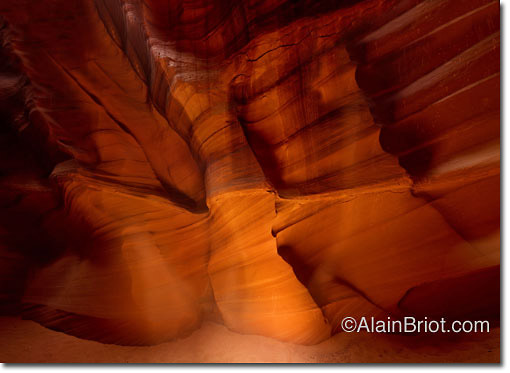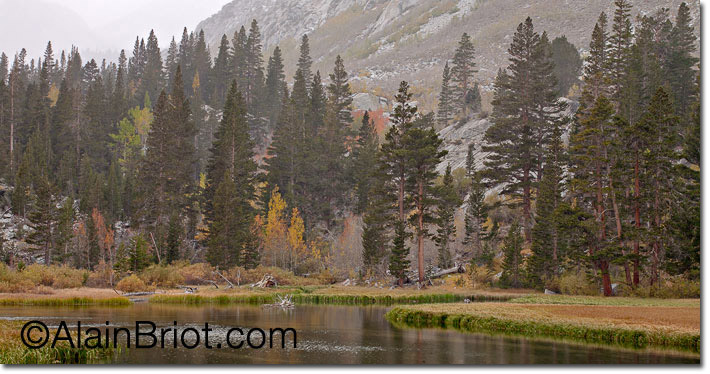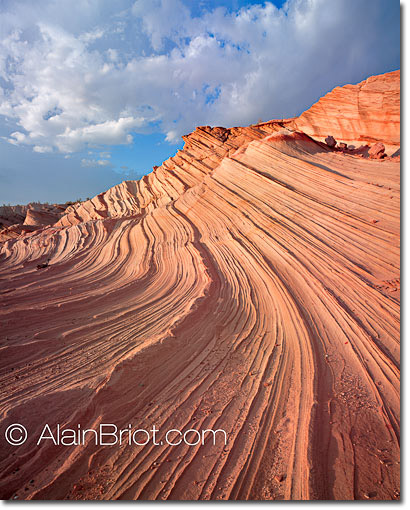What is Fine Art Photography? Part 1 of 3 |
Art implies control of reality, for reality itself possesses no sense of the aesthetic. Photography becomes an art when certain controls are applied. - Ansel Adams
1 - Introduction
I recently wrote a book on Marketing Fine Art Photographs (this series of 3 essays is Chapter 1 in the book). As I started to write, I realized that it was important to first define what fine art photography is. I also realized that doing so was challenging for several reasons.
First, fine art photography is not all that common, which means that there are not many practitioners to talk to. Furthermore most practitioners are more interested in doing fine art photography than in explaining what it is.
Second, photography has many purposes, only one of them being the creation of fine art photographs. Photography can be used to record and document events, for scientific or forensic research, to capture personal memories, and much more. All of these uses result in the creation of photographs, yet none are intended to be fine art photography.
Third, there is a tendency on the part of some photographers to lower the criteria for fine art photography for commercial reasons. Creating fine art photography can be expensive. However, these expenses can be recouped, and then some, through the higher prices a photographer can charge for fine art photographs. Unfortunately, some photographers claim that their work is fine art when in fact it does not meet the quality standards for fine art. This has led to a general misunderstanding of what fine art photography really is.
Fourth and last, the distinctions between photography and art can be blurry. Does art include photography? Before we can consider what fine art photography is, we must first determine whether or not photography is an art.

Marketing Fine Art Photography, Rocky Nook June 2011
In this essay I will give answers to the questions above. However, I do want to point out that the primary purpose of this essay is not to answer the question “what is art?” but rather “what is fine art photography?”
In the context of the above remarks it is worth pointing out a couple of things. First, asking “what is art?” means questioning the nature of art as a human endeavor regardless of the medium being used. On the other hand, asking “what is fine art photography?” means questioning the nature of photography practiced as a fine art. The purpose of this essay is to discuss the nature of fine art photography, not the nature of art as a whole. While it is inevitable that I discuss “what is art” in this essay, those who want to read a full-fledged discussion focusing only on the nature of art will have to wait until I write a essay devoted solely to that subject.
I also want to point out that because of the subjective nature of art, not all readers will agree with my views on the subject. I point out some of the reasons for this situation, and I also talk about how to handle disagreements and criticisms, later on in this essay.
Finally, I want to point out that I carefully pondered this issue before I started writing this essay and that I concluded that, to use a common expression, “I agreed to disagree.” In my view, the only way to write about art is to take it for granted that not everyone will agree and that many will consider what follows to be opinions rather than facts. I therefore decided to not let this hinder me, or worse stop me, from addressing this subject.
2 - Defining Fine Art Photography: A Checklist
I present the answers to the question of “what is fine art photography?” as a checklist. This checklist will be useful in helping you find out if your work, or that of other photographers, qualifies as fine art. There are three aspects to fine art photography and so I have divided this checklist into three parts: A) artistic, B) technical, and C) marketing.
A – Fine Art Photography: The Artistic Aspects
1 – Fine art photography is first about the artist. Fine art photography is first about the artist, second about the subject, and third about technique. The artist is the most important element in the creation of art. The same artist may, and often does, work with various subjects during his career, using a number of different techniques and possibly a variety of mediums. The goal is to create a work of art; subjects and techniques are both vehicles used in the process of reaching this goal.
2 – The photographer must consider himself an artist. The photographer must consider himself an artist in order to create art. Imagine how difficult it would be to create fine art photographs if you did not think of yourself as an artist. Further, although you might be able to create art, imagine how difficult it would be to write an artist statement if you did not believe you were an artist. The artist statement is an essential document to have when pursuing a career as an artist. It directly addresses how the artist looks at himself, his experience, approach, goals, and work. Not being able to write one would have a negative impact on your artistic career.

Sandstone Waves, Antelope Canyon
This photograph is actually not one that I have taken with my camera alone. Instead, it is a collage of eight photographs, stitched together in Adobe CS4 using Photomerge. The stitching setup I chose distorted the image to the point that blank areas appeared in the corners. Since I did not have additional photographs to fill-in these blank areas, and since I liked the image and wanted to finish it, I decided to clone substantial areas of the image. In doing so I truly “invented” part of the photograph using as guidelines the areas that I had photographed. The result is an image of something that does not quite exist as it is shown here. It is the work of my imagination as much as that of my camera. As such I believe it represents a work of art, as well as a combination of art and science.
3 – The artist must demonstrate control of the creative process and of the final outcome. This statement directly informs the place that luck, happenstance, and other “happy events” have in the creation of art. While there is no doubt that all these do come into play, their value comes in only when the artist has done his best to control the outcome of the work. At that time, luck usually works in favor of the art rather than against it. But while luck may be a component of the process, it is not responsible for an artist’s success over an entire career, or for demonstrating the highest level of craftsmanship in the completion of complex projects. It is the artist’s control of the process that is responsible for these achievements.
Furthermore, because art is first about the artist, it is essential that the artist controls the work. Only through this control can the artist’s personality, inspiration, passion, and vision become part of the work. Only through this control can the artist share his vision through his work. Ultimately, what the audience wants is to see how a specific artist views the world, and this can only take place if the artist assumes full control of the creation of a work of art.
Beginning artists often argue against the necessity of controlling their creations. Experienced artists rarely hold this type of discourse. Beginning artists feel more comfortable having the work exist by itself, disconnected from their responsibility towards it. They can be reluctant to take responsibility for the nature and the facture of their work. This is often because of a certain level of shyness regarding their creation, a shyness they cope with by presenting the work as being due to something outside of their control rather than as being the outcome of their personal vision. As artists become more experienced, as they find an audience for their work, and as their work becomes more accepted, taking responsibility for the outcome of their efforts starts to replace the disconnection with their work that they originally displayed.
As artists start to accept more responsibility for their output, they begin to exert more control over their creations. As a result, the necessity for a higher level of craftsmanship begins to surface, and in turn a higher level of mastery begins to take shape.
These developments are motivated by the realization that being responsible for the outcome of the work also means being responsible for the level of craftsmanship demonstrated in the work. A sense of pride starts to build in the artist and the desire to demonstrate one’s abilities surfaces. In due time, the artist becomes concerned with demonstrating mastery of his art to his audience. At this point, the transition from refusing responsibility for the work to taking full control over the outcome of the work is complete.
4 – A fine art photograph is done with the goal of creating a work of art. This further reinforces the necessity for the photographer to consider himself an artist and to take control of the creative process. Both of these are necessary if one is to create a work of art and not simply a documentary photograph. We will discuss this in greater detail later in this essay.
Creating a fine art photograph means creating an image that goes beyond the literal aspect of the scene or the subject photographed. It means creating an image that shares a personal vision, a message, or a metaphorical aspect. It means creating a photograph, not just taking a photograph.
5 – A fine art photograph is not just documentary. Documentation is favored in certain types of photography, such as scientific and forensic recording. In these fields the purpose for taking a photograph is to record the scene or the subject in the most literal and factual manner possible so that what the photograph shows is as close as can be to what the witnesses, researchers, and investigators saw. The goal is to prevent the personality and the opinions of the photographer from becoming part of the photograph. The person who took the photograph must be totally absent from it. Their personal beliefs, views, and opinions should in no way be present or expressed in the photograph, either implicitly or expressively. It is as if this person never existed, as if the camera took the photograph by itself.
Fine art photography is the exact opposite. In fact, we can take each of the statements above, write exactly opposite statements, and have excellent guidelines for the creation of fine art photographs. Let’s give it a try. First, what a fine art photograph shows must be different from what observers present when it was taken saw. Second, the purpose of a fine art photograph is to share the photographer’s personal vision of the scene or subject. Finally, the person who took the photograph must be present in the image, metaphorically speaking. When looking at a fine art photograph we must know that the photograph was created by an artist and not just by a camera.
This is because art is the opposite of documentation. Art is the expression of the artist's personality, vision, and inspiration. As such, a fine art photograph is a vehicle through which the artist shares his vision with his audience. Therefore, to be considered art a photograph can in no way be purely documentary. Instead, it must primarily be expressive. This expression must reflect the artist’s personality, inspiration, vision, personal style, and, most importantly, emotional response to the subject. The photograph cannot just show what was in front of the camera, it must also show what the photographer felt.
6 – The image represents an interpretation of the subject. As we just saw, a fine art photograph is always an interpretation of the data captured in the photograph. In fine art landscape photography this interpretation starts in the field when the photograph is taken and continues in the studio when the photograph is converted and optimized. (More on this in Section B-Technical Aspects, below.)
7 – A fine art photograph has an emotional content. As we saw previously, the image must express the artist’s emotional response to the subject. For this to happen there must be an emotional content in the photograph. Because photographs are purely visual, this emotional content must be expressed visually. This is done through various means: the composition of the image, the choice of image format, the cropping of the original photograph, the choice of color palette, color saturation (or the use of black-and-white or color monochrome instead of color), contrast and lightness, the use of curves, lines, and other visual elements, and more.
The choice of these elements defines one’s personal style. To be used effectively, this approach requires extensive study, training, and practice. To minimize the amount of time required to learn it, it is best to study under the guidance of an experienced photographer.
8 – The composition of the photograph is complex and sophisticated. By complex and sophisticated, I do not mean that the composition must be complicated. I simply mean that it needs to have multiple layers of meaning. A composition can be very simple, minimalist even, and still have multiple layers of meaning. These different layers each represent a different level of understanding and appreciation of the work. There needs to be more to the composition of a fine art piece than meets the eye at first glance. The meaning of the image must reveal itself over time, not all at once. As the viewer spends time admiring, studying, and reflecting on the piece his efforts are rewarded by a deeper understanding of the work.

North Lake, Eastern Sierra Nevada
A fine art photograph does not have to be one that conceals the location where it was taken. It can be an image of a scene all of us can recognize and relate to. However, all the aspects of the work discussed in this essay must be there to testify that the photograph is a representation of the photographer’s emotional response to the scene and not just a documentary record of this scene.9
9 – A metaphorical level of meaning is present in the image. A metaphor is something that stands for something else. Metaphors can be expressed through a variety of mediums: writing, visual arts, music, architecture, etc.
Metaphors are not necessarily self-evident. Because metaphors are arbitrary, they are by nature cultural and will therefore vary from one culture to another. An object that stands for something in a given culture may stand for something entirely different in another culture. For example, red roses are symbols of love in American culture and symbols of socialism in Europe. Although the origin of the rose as a symbol of love originated in Europe in the middle ages, the origin of the rose as a symbol of socialism originated in France in May 1968, when red roses were used as badges during street protests in Paris. One must therefore know the cultural context in which a metaphor exists in order to understand its meaning.
In fine art photography metaphors must be expressed visually by using elements that are either already present in the scene or placed there by the photographer. These elements are used to express a metaphorical level of meaning that extends beyond the visual contents of the image.
For example, in a fine art landscape photograph a young tree located next to a mature tree may be used to represent the contrast or the transition between youth and old age. In this instance, the trees have a metaphorical meaning that extends beyond their visual presence. The young tree stands for youth while the mature tree stands for old age. Similarly, a pool of dark water may be made to stand for mystery, or the reflections of clouds in water for infinity and introspection, and so on. The possibilities are infinite and limited only by the artist’s imagination.
10 – The emphasis is on quality rather than quantity. When creating fine art photographs the artist’s emphasis must be placed on quality rather than quantity. This approach must permeate every aspect of the photographer’s endeavors.
This is because the process of creating fine art is characterized by deep thinking, deliberate actions, and attention to detail in every aspect of the work. As such, the process of creating fine art naturally results in a small number of individually made, high-quality pieces. The artist’s emphasis is on the creation of a small number of individual pieces rather than on the mass production of identical objects.
Only by limiting the number of pieces can one control the quality throughout the entire process. Because we all have the same amount of hours available in a day, increasing quantity means having to create more pieces in the same amount of time. This means spending less time working on each piece, which in turn means that less time is available to pay attention to details and to ensure that every aspect of the work is completed to the highest standards.

Slickrock, Navajoland
11 – Cost considerations are secondary. In the creation of fine art photographs, the primary concern is for quality. Costs, be it that of your equipment (cameras, lenses, computers, etc.) or your supplies (film, paper, inks, mat board, frames, etc.) are secondary.
Creating fine art photographs is not about trying to save money by buying lower-priced equipment or supplies. It is about creating the finest piece possible regardless of cost. While we all have a limit to how much we can spend on our art, concerns for costs need to come second, not first.
12 – The artist wrote an artist statement. The contents of an artist statement are described in Essay 20. It is an important document because it describes who the artist is, what he does, what his training and experience are, and how he is positioned in the art field. As such, it legitimizes the artist, his vision, and his goals.
13 – Individual pieces are part of a larger body of work. A body of work says more about an artist’s abilities than a single photograph. This is because a body of work, such as a portfolio, demonstrates the artist’s abilities over time instead of in a single instance. A single, high-quality photograph can always be seen as a fluke by a suspicious audience. However, a portfolio of quality images puts these suspicions to rest by positively answering the question, “Can the artist create images of this quality regularly, or is this just a happy accident?” It is much easier to see if the artist can regularly produce quality work and sustain his vision over time when looking at a portfolio than when looking at a single image.
14 – The work is discussed in relationship to other works of art. The work is discussed in relationship to other works of art and comparisons are made. In this discussion, foundational aspects of art are addressed, such as pedigree, provenance of the work, facture (meaning execution), history, palette, etc.
In parts 2 and 3 we will look at the technical and finally at the marketing aspects of fine art photography. Stay tuned to next month's edition!
Comments on NPN landscape photography articles? Send them to the editor. NPN members may also log in and leave their comments below.
 Alain Briot creates fine art photographs, teaches workshops and offers DVD tutorials on composition, conversion, optimization, printing and marketing photographs. Alain is also the author of Mastering Landscape Photography. Mastering Photographic Composition, Creativity and Personal Style and Marketing Fine Art Photography. All 3 books are available from Amazon and other bookstores as well from Alain’s website.
Alain Briot creates fine art photographs, teaches workshops and offers DVD tutorials on composition, conversion, optimization, printing and marketing photographs. Alain is also the author of Mastering Landscape Photography. Mastering Photographic Composition, Creativity and Personal Style and Marketing Fine Art Photography. All 3 books are available from Amazon and other bookstores as well from Alain’s website.
You can find more information about Alain's work, writings and tutorials as well as subscribe to Alain’s Free Monthly Newsletter on his website at http://www.beautiful-landscape.com To subscribe simply go to http://www.beautiful-landscape.com and click on the Subscribe link at the top of the page. You will have access to over 40 free essays by Alain, in PDF format, immediately after subscribing.
Alain welcomes your comments on this essay as well as on his other essays. You can reach Alain directly by emailing him at alain@beautiful-landscape.com.